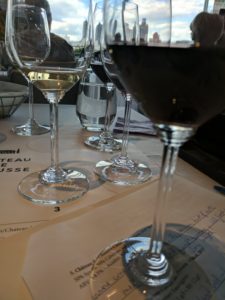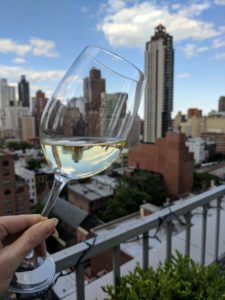 Most of the hype surrounding Provence lately has been about its preponderance of rosé, which is only natural given that 89% of its production is pink and that its rosé sales have quintupled over the past five years. However, the region also produces some high-quality whites and reds as evidenced by a tasting with Château de Chausse. As the winery’s General Manager, Franck Bailleul proposed, “The reds from Provence are to be discovered,” and I agree.
Most of the hype surrounding Provence lately has been about its preponderance of rosé, which is only natural given that 89% of its production is pink and that its rosé sales have quintupled over the past five years. However, the region also produces some high-quality whites and reds as evidenced by a tasting with Château de Chausse. As the winery’s General Manager, Franck Bailleul proposed, “The reds from Provence are to be discovered,” and I agree.
Château de Chausse made its New York debut this June having been acquired by real estate developer, Charles S. Cohen, in 2016. As my friend Charles remarked, “It’s good to be rich.” Cohen made his money in real estate development at the helm of Cohen Brothers Realty Corporation, developing properties in New York, Los Angeles, South Florida and elsewhere. A film buff since his teens, Cohen then added French film distribution to his portfolio (and presumably adding to his fortunes) with the creation of Cohen Media Group in 2008, before deciding that he would like to someday own a vineyard.
As he was quick to admit, Cohen knew his limitations and therefore sought out an estate not in Burgundy, but in Provence since he had always been in love with rosé. Shortly after making his intentions known, a brochure came across his desk and he was soon in pursuit of the Château de Chausse estate in the Alpes-Côte d’Azur region of Provence, close to the glitz and glamour of St. Tropez. After 30 years of ownership, the Schelcher family was ready to sell (and retire) and Cohen was eager to buy.
With well-stocked coffers (Forbes puts Cohen’s net worth at 2.8 billion), the watchword from Cohen to his new colleagues has been quality, a philosophy that permeates throughout the winemaking process, from the vineyards, which are all harvested by hand, to the redesigned labels. They are assisted in this latter effort by Cohen’s current wife, Clodagh “Clo” Margaret Jacobs, who knows more than a thing or two about luxury marketing, having brought Jimmy Choo shoes to the streets of Manhattan.
Aside from the Cohens and Bailleul, the winery is in the capable hands of Laurence Berlemont who quipped, “I came with the furniture,” when asked how the two had found her. In fact, her agronomy consulting firm, Cabinet d’Agronomie Provencale, had been hired by the previous owners and she has been actively involved with Château de Chausse since 2009.
Bailleul describes the 135-acre estate as both a dream and a jewel. Much of the property is given over to a protected forest, with only 37 acres of planted vineyards permitted. Consequently, the vines are surrounded by trees, shielding them from the elements. Moreover, Provence’s near perfect Mediterranean weather makes it relatively easy to grow grapes and the winery is on track to becoming certified organic by next year.
Interestingly, while Cohen expected to purchase a rosé-centric estate, Château de Chausse divides its production among reds (45%), whites (15%) and rosé (40% ). With a limited production of only 70,000 bottles annually, Château de Chausse wines will only be available in New York, Paris and Provence.
 TASTING NOTES
TASTING NOTES
Château de Chausse Blanc 2016 Côtes de Provence, France
This 100% Rolle (aka Vermentino) is crafted from grapes harvested on two separate occasions, one week apart, yielding a wine with pronounced floral, citrus and peach aromas. On the palate, it is rich and round, with very ripe tree fruit, but beautifully balanced with high acidity, medium+ body and long length.
NB: Berlemont advised that this wine is capable of aging for three to four years, at which point, the wine will be redolent of apricots and almonds.
Château de Chausse Rosé 2016 Côtes de Provence, France
With its barely perceptible pink hue, this wine offered up berries and melon on the nose, which persisted on the dry palate. Good acidity.
Château de Chausse Diamant Blanc 2016 Côtes de Provence, France
This wine represents a new approach for the winery, which made a small (1,000 bottles) trial of fermenting and aging Rolle in barrel. The oak treatment is evident on the nose, with smoky and oaky aromas, co-mingled with citrus and tree fruit. Yet, despite the obvious oak, the barrel notes are well integrated on the palate and the wine itself is quite elegant.
Château de Chausse Rouge 2013 Côtes de Provence, France
Enigmatically, there was a lot of Cabernet Sauvignon planted in Provence during the early 1990s and it accounts for 50% of this wine, with the other half being Syrah. Aromas of meat, spice and red fruit greet the nose, with red and black fruit, herbal and vanilla notes on the palate. Given their structure, Château de Chausse holds its reds back until they are ready to drink and consequently, 2013 is the vintage currently in the market.
Château de Chausse Rouge 2012 Côtes de Provence, France
Although it contains the same 50% Cabernet Sauvignon-50% Syrah blend as the previous wine, the 2012 is more Syrah-like in nature with more pronounced earth and leather aromas and flavors. It is still fresh and fruity despite its age, with long length.
Château de Chausse Rouge 2011 Côtes de Provence, France
The 2011 was starting to show some development on the nose with dried fruit and vanilla aromas. On the palate, the acidity was still bright and the tannins were well resolved.
Château de Chausse Rubis Rouge 2013 Côtes de Provence, France
The flagship Rubis, produced in small quantities (1,200 bottles) is essentially a monovarietal Syrah, but since AOP rules require the presence of another grape, it also contains 10% Cabernet Sauvignon. This is a powerful, full-bodied wine with smoke, leather, meat and very ripe red fruit on the nose and palate, culminating in long length and a woodiness in the finish.
Château de Chausse Rubis Rouge 2010 Côtes de Provence, France
This older vintage of Rubis was still quite powerful with firm tannins and a darker fruit profile.
